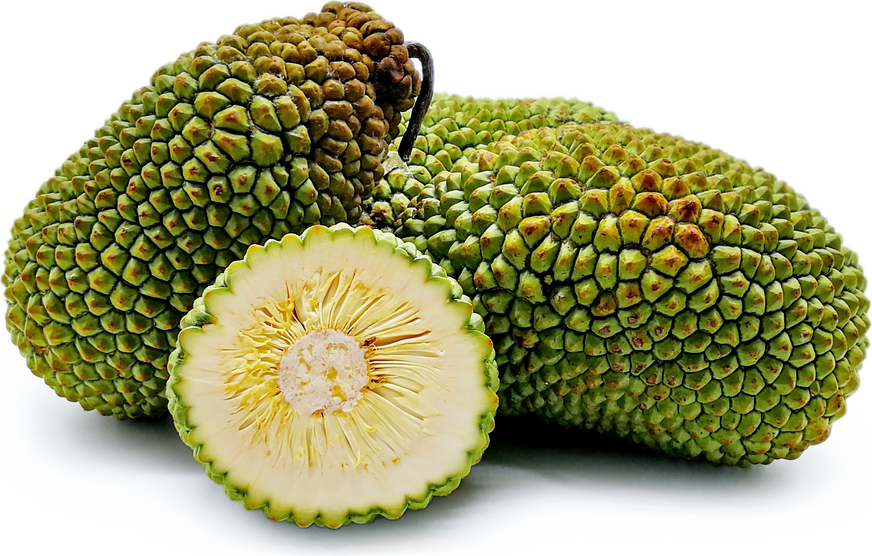


Durian Cempedak
Estimated Inventory, lb : 0
Description/Taste
Durian cempedaks are an elongated oval-shaped fruit that averages around 25 centimeters long and 12 centimeters wide. They can weigh about 900 to 3,000 grams each. Their bright green skin is covered in raised, hexagonal spikes with amber-brown tips. This gives the surface a jagged, warty texture, but each spike feels surprisingly soft to the touch. When sliced lengthwise, Durian cempedaks reveal large seeds that resemble oversized corn kernels. These seeds are around 3 centimeters in diameter by 2.5 centimeters in length and are covered with a thick layer of edible orange-yellow flesh. Durian cempedak flesh takes on a different appearance when cut in half width-wise, resembling a pineapple with its golden hue. The outer flesh is solid, becoming more shredded towards the middle of the fruit. In the very center is a white-yellow core with a creamy, chalk-like texture. The flesh exudes a sticky, glue-like white sap and has a soft, juicy, custard-like consistency. Durian cempedaks emit a musky yet honeyed scent, with a sweet, caramel flavor that carries hints of mango.
Seasons/Availability
Durian cempedaks are available primarily in the summer, with an occasional second season in winter.
Current Facts
Durian cempedaks are botanically classified as Artocarpus integer and belong to the Moraceae, or mulberry, family that also includes jackfruit, breadfruit, and figs. They are a variety of cempedak, the two other common cultivars being Kuala Nerang and Sik. Durian cempedaks are smaller than standard cempedaks, with a stronger aroma, durian-like flavor, and a bright green hue, as opposed to the brown-yellow color of the standard variety. The cempedak species originated in Southeast Asia along with other tropical fruits like Wood apples, Santols, and Snake fruit. Cempedaks like the Durian variety are used not just for their culinary values but the wood from their trees. This strong, durable wood is made into boats and furniture or used to create yellow dyes.
Nutritional Value
The nutritional value of Durian cempedaks isn’t widely known, but cempedaks are generally high in vitamins A and C. These nutrients encourage immune function, cell growth, wound healing, iron absorption, collagen production, and vision, skin, and reproductive health. Cempedaks are also a source of riboflavin, supporting the nervous system, energy production, healthy hair and nails, and the prevention of migraines and oxidative cell damage. These fruits contain fiber to promote digestion and gut health, lower blood sugar and cholesterol levels, and control appetite. The potassium in cempedaks regulates fluid balance, muscle and nerve function, blood pressure, bone health, and metabolism. The bark of cempedak trees has been used historically to heal wounds, prevent infections and fever, and create poultices for feet, hands, and ulcers.
Applications
Durian cempedaks are eaten fresh out of hand, dried, boiled, preserved, or fried. To use, cut the fruit open lengthwise, peel apart the flesh, and dig the seeds out by hand or with a spoon. The remaining pulp can blended with coconut milk, vanilla, and other tropical fruits to create ice cream or puréed with condensed milk and chocolate for truffles. Durian cempedak flesh can also be used in curries or boiled and enjoyed like small potatoes. This fruit is often transformed into syrup, dried into jerky, or chopped in small pieces for baked goods like cakes and muffins. Durian cempedaks may be fried into fritters or boiled with salt to create a nutty, water chestnut-like texture. This variety pairs well with jackfruit, bananas, pineapple, coconuts, mangoes, strawberries, yams, pumpkins, taro, carrots, hazelnuts, almonds, caramel, chili powder, turmeric, cumin, limes, sesame seeds, ginger, and garlic. Slicing into the fruit will cause it to exude a sap that becomes stickier over time so cutting surfaces, hands, and knives should be covered with oil before handling the fruit. Store Durian cempedak at room temperature, where they will last for five to seven days.
Ethnic/Cultural Info
Cempedaks are one of the foods used and sold by the Orang Asli communities in Malaysia. For generations, this indigenous group has practiced agroforestry, combining fruit cultivation with the natural resources of their surrounding forest ecosystems. The Orang Asli people engage in various agroforestry methods, including gathering, fishing, hunting, and home gardening, to sustain both local and international economies. Fruits like durian, rambutan, mangosteen, and cempedak are vital crops that hold both financial and cultural value. Durian is the most profitable of these fruits, valued for both its fruit and timber, generating the highest average income, with cempedak being the second most profitable.
Geography/History
Durian cempedaks are native to the region of Southeastern Asia that extends from Malaysia to Papua New Guinea. The cempedak species is frequently cultivated in Indonesia, Southern Thailand, and Borneo. Durian cempedaks grow in tropical climates with plentiful water and sun exposure. They may be found in the wild forests of Southeast Asia but are more commonly cultivated as crops by the indigenous Orang Asli people of Malaysia. This species has been brought to the non-native regions of Australia, Jamaica, Zanzibar, Kenya, and Hawaii, where it is occasionally cultivated for private and commercial use. The Durian cempedak variety may be found in small quantities in markets and gardens around Southeast Asia but is rarely sold outside of this area.









